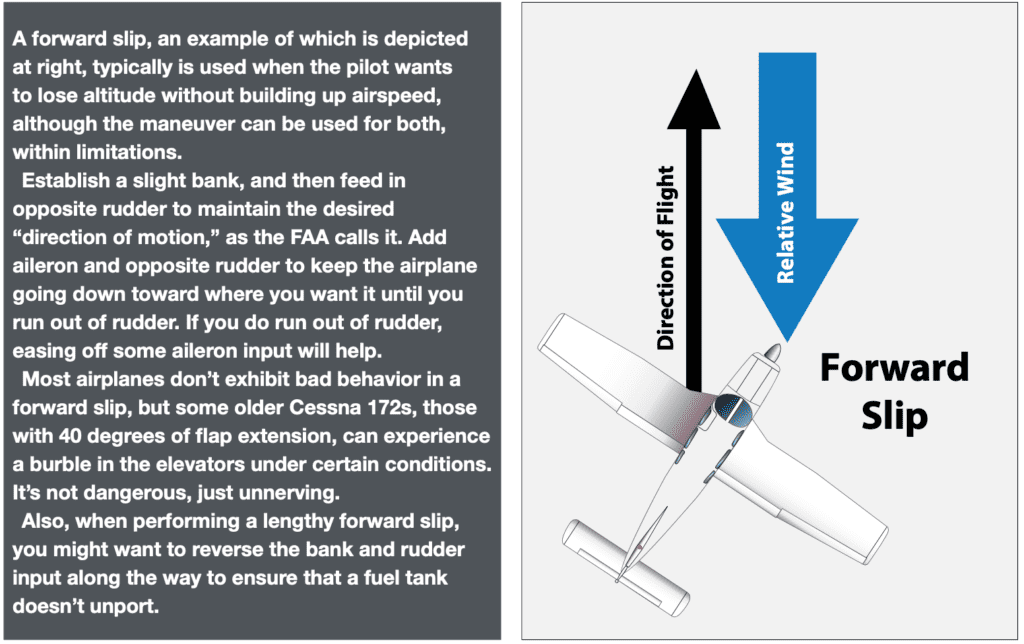The FAA defines a slip as a condition in which the airplane’s bank angle is “too steep for the existing rate of turn.” In other words, the airplane is not in coordinated flight, which in fact could be the pilot’s desire. For example, slipping is a time-honored way to lose altitude quickly in an airplane lacking wing flaps or one that’s simply too high for one reason or another. And unless we touch down crabbed at an angle to the landing surface when dealing with a crosswind, we are in a slip, with the upwind wing lowered into the breeze.
Getting into a slip requires either intent or sloppy flying, and most modern airplanes are designed with one feature or another that resists slipping from sloppy flying. In both the crosswind and altitude-loss examples, some rudder is required to prevent the turn rate from catching up to the bank angle, which we’ll get to in a moment. For now, however, understand that the two kinds of slips have different names in addition to different purposes. And their naming convention is backward.
WHAT’S IN A NAME?
According to the FAA’s Airplane Flying Handbook (PHAK, FAA-H-8083-3C), “Sideslips are frequently used when landing with a crosswind to keep the aircraft aligned with the runway centerline. A forward slip, on the other hand, “is used to dissipate altitude and increase descent rate without increasing airspeed.” The FAA says the forward slip is so named because the airplane’s “direction of motion continues the same as before the slip was begun.” In a sideslip, on the other hand, “the airplane’s longitudinal axis remains parallel to the original flightpath, but the airplane no longer flies straight ahead.” So even though the airplane is going where we want it in both examples, the type of slip we’re performing depends on direction of motion and the airplane’s longitudinal axis.
In our opinion, the naming convention is bass-ackward, since when performing a sideslip to land in a crosswind, the airplane is proceeding forward, hopefully aligned with the runway, while a forward slip places the airplane’s fuselage slightly sideways, into the relative wind, thus increasing total drag and descent rate.
With that off our chests, both slip types involve using the ailerons and the rudder to perform the uncoordinated maneuver. Put another way, we use aileron to establish the bank and rudder to keep the airplane going where we want. This is easily understood when performing the sideslip in a crosswind landing: lower the upwind wing and use opposite rudder to control heading.
RUDDER AUTHORITY
Depending on the airplane and conditions, it’s usually rudder authority that limits what we can do in a slip. In a forward slip starting with a healthy altitude, for example, it’s relatively easy to crank in a bit of aileron and maintain the original track with rudder. Cranking in a lot of aileron, instead, and continuing to try holding that track will quickly demonstrate that rudder authority is the limiting characteristic.
The importance of rudder authority in a sideslip countering a crosswind can’t be overstated, either. We’ve seen many instances where gusts or just steady-state winds force us to bottom out the rudder pedal in a crosswind sideslip. If you absolutely, positively must land on that runway in this wind, one way to compensate for lack of rudder authority is to approach the runway at a shallow angle from slightly downwind, with the sideslip established. By heading even slightly into the wind, you can “buy” yourself some additional rudder authority. Not much, and perhaps not enough, but some. But it’s also easy to run out of runway width in such a maneuver.

WHATS A FORWARD SLIP FOR?
Using a sideslip in a crosswind is almost self-explanatory, especially if you don’t have a spare set of landing gear handy and want to avoid touching down in a crabbed attitude, although a partial crab also can help out with rudder authority issues. But how does one use a forward slip?
If you got your initial training in, say, a Piper Cub or Aeronca Champ, or another airplane lacking wing flaps, you’d know that by turning the airplane slightly sideways into the relative wind while maintaining its desired track is another arrow in your quiver when trying to get into short fields, compensating for a high approach or both. The maneuver also works when flying airplanes with flaps. Essentially, by increasing the airplane’s drag in a forward slip, we’re accepting a greater descent rate at a higher airspeed than might otherwise be desirable.
Some things to keep in mind include clearing the engine periodically during the resulting descent, just like you would in a lengthy straight-ahead glide at idle power. Also, don’t exceed any operating limitations, like maximum flap extended speed (the white arc). Some airplanes may exhibit airspeed errors in a forward slip, thanks to pitot tube and static port position.
RECOVERING
Recovering from a forward slip—or a sideslip, for that matter, if you want to go around—is simply a matter of smoothly reversing the control inputs you made when entering it and returning to coordinated flight.
Typically, an airplane in a slip “displays very little of the yawing tendency that causes a skidding stall to develop into a spin,” according to the PHAK. Nevertheless, it can be a bit eerie nibbling around at the bottom of the white arc in such an attitude. Always consult your POH/AFM for additional guidance.




